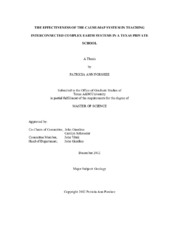| dc.description.abstract | The six subsystems of Earth (atmosphere, hydrosphere, lithosphere, biosphere, cryosphere and anthroposphere) are complex and dynamic. Because all subsystems are linked, study from an independent perspective and a composite perspective is fundamental. Unfortunately, because of current instructional methods, students tend to consider these systems unrelated and use linear cause and effect models where little to no interaction occurs between different systems and the components. The simplistic and incorrect view of systems is the fundamental reason more education about Earth systems science is necessary in the K-12 curriculum.
In this study, the Cause-MaP system of studying complex Earth systems in a private intermediate school in Texas was evaluated. The objective was to ensure that students are more aware of how Earth affects them and vice versa. An added benefit of the study was the opportunity to teach scientific reasoning. Students completed a pre-unit test to measure a priori knowledge. The students then worked through a modified Cause-MaP system in which they took notes in a structured table format; then each created a concept map. Students completed these steps for two subsystems: hydrosphere and lithosphere. The individual concept maps were used to assess knowledge and understanding of the individual systems by each student. At the end of the unit, students created composite concept maps which included each system they studied in this unit, to illustrate the interconnectedness of Earth systems. Based on the number of components and processes included, the students’ maps were evaluated to determine their understanding of the interactions between multiple Earth systems. The students’ maps were grouped based on the number of components and processes included in the concept maps. A post-unit test was also administered, which included two similar questions. The pre-unit test was completed again to check the overall progress of the students involved in this study. The students showed, with practice and encouragement from their instructor, that they recognize intersystem connections in complex Earth systems. With more integration of programs like these, students will become more proficient in recognizing system interactions. | en |


